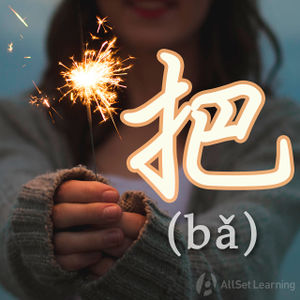Difference between revisions of "Advanced uses of "ba""
| Line 42: | Line 42: | ||
==Take something seriously with 当回事== | ==Take something seriously with 当回事== | ||
| + | |||
| + | 当回事 is mostly used in colloquial Chinese. It means to take something seriously or to hold something in high regard. It is usually used with the negative 不. | ||
<div class="jiegou"> | <div class="jiegou"> | ||
Revision as of 03:54, 28 April 2016
| This article is a stub. Editors can help the Chinese Grammar Wiki by expanding it. |
-
Level
-
Similar to
-
Used for
-
Keywords
- Also known as: 把字句 ("bǎ"zìjù), 把 construction, preposition 把, disposal construction and pre-transitive 把.
Once you've gotten the hang of the basic 把 (bǎ) sentence pattern, you can start to use it in some more complex and abstract ways.
Contents
Using 把 with 给 and a verb
Used in oral Chinese to add emphasis when dealing with something.
Subj. + 把 + Obj. + 给 + Verb Phrase
- 我 把 这 事儿 给 忘 了 。I forgot about this thing.
- 周末 我 把 脏 衣服 给 洗 了 。On weekends, I wash the dirty clothes.
- 你 能 把 这 些 都 给 记住 吗?Will you be able to remember all of this?
Using 当作 or 看作
When you want to say that something is treated as something else, use this pattern.
把+ Obj.+ 当作 / 看作 + something else
- 我 把 他 当作 我 哥哥。I see him as my older brother.
Take something seriously with 当回事
当回事 is mostly used in colloquial Chinese. It means to take something seriously or to hold something in high regard. It is usually used with the negative 不.
(别/不)把 + Obj.1 + 当回事
Verb +成
In this case, 成 can be translated as "into." The first example of this is for concrete objects.
把+ Obj. 1 + Verb (切/做/分/打扮) + 成 +Obj. 2
In the example below, we are dealing with more abstract verbs.
把 + Obj. 1 + Verb (换/变/改/看/当/转/转换/翻译/说) + 成 + Obj. 2
The example below is when somebody mistakes something for something else. This can be either mishearing, misspelling, seeing something as something else, etc.
把+ Obj. 1 + Perception Verbs (看/听/写/记)
See also
Sources and further reading
Books
- A Practical Chinese Grammar For Foreigners (外国人实用汉语语法) (pp. 461-70) →buy
- Basic Patterns of Chinese Grammar (pp. 53-4) →buy
- Chinese: An Essential Grammar, Second Edition (pp. 159-64) →buy
- Chinese Grammar Without Tears (简明汉语语法学习手册) (pp. 167-81) →buy
- Common Chinese Patterns 330 (汉语常用格式330例) (pp. 3-5) →buy
- Integrated Chinese: Level 1, Part 2 (3rd ed) (pp. 142-4) →buy
- Integrated Chinese: Level 2, Part 2 (pp. 225-7, 321-3) →buy
- Mandarin Chinese: A Functional Reference Grammar (pp. 463-92) →buy
- Modern Mandarin Chinese Grammar: A Practical Guide (pp. 354-5) →buy
- New Practical Chinese Reader 2 (新实用汉语课本2) (pp. 41-2, 88) →buy
- New Practical Chinese Reader 3 (新实用汉语课本3) (pp. 15, 51, 101-2) →buy
- 40 Lessons for Basic Chinese Course (基础汉语40课下册) (pp. 369-70, 384, 398-9)→buy
Websites
- Mandarin Essential Grammar (Yale): 把 Construction
- CTCFL (Oxford): The 把 Construction
- ChinesePod: Qing Wen - The Magic Word 把 (free podcast content)
- ChinesePod: Qing Wen - 把 Humbug (free podcast content)
- FluentU: The Definite Guide to the Chinese Ba Construction
- Mandarin Online: 把字句
- Just Learn Chinese (blog): Lesson 10 How to understand and use Chinese sentence pattern “…把…”?



